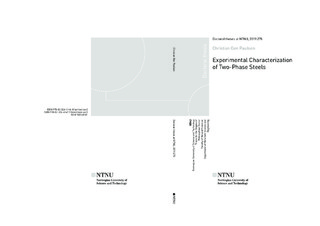| dc.contributor.advisor | Westermann, Ida | |
| dc.contributor.author | Paulsen, Christian Oen | |
| dc.date.accessioned | 2019-10-21T11:30:57Z | |
| dc.date.available | 2019-10-21T11:30:57Z | |
| dc.date.issued | 2019 | |
| dc.identifier.isbn | 978-82-326-4147-5 | |
| dc.identifier.issn | 1503-8181 | |
| dc.identifier.uri | http://hdl.handle.net/11250/2623524 | |
| dc.description.abstract | This thesis consists of several in-situ scanning electron microscope (SEM) tensile test studies of different two- phase steels. Three different two-phase steels have been investigated: a NVE36 plate steel, a dual-phase (DP) plate steel, and a super duplex stainless steel (SDSS) from a pipe. In each of these steels, one phase is ferrite and the second is pearlite, martensite and austenite, respectively. The interactions between the two phases in the microstructure have been investigated by utilizing recent advances in scanning electron microscope (SEM) in-situ tensile testing in combination with digital image correlation (DIC), electron backscatter diffractions (EBSD) and SEM micrographs acquired using secondary electron imaging.
A main part of the Ph.D. work had concerned the establishment of an experimental technique to create contrast when imaging a specimen surface in an SEM. Here, a polished specimen is coated with a continuous gold layer using a gold sputter coater. This continuous layer is then remodeled by placing the specimen on a hot plate with a gas flowing across the surface. The result is a specimen surface covered in random gold speckles. Using this technique, the goal was to create a pattern on different two-phase steel specimens with sufficient contrast when imaging at large magnifications in an SEM. A representative area of the tested specimen containing this pattern was then recorded throughout an in-situ SEM tensile test. The in-house DIC software eCorr then analyzed the resulting image series. The result is a strain map with a spatial resolution capable of resolving strains at a sub- grain level.
Throughout this work, several studies were undertaken in order to verify the technique and methods used. First, a study on the effect of heat treatment on the steels investigated was conducted. Second, the DIC results were verified by comparing the grain rotations measured in DIC and EBSD. Third, two different speckled patterns were compared to highlight differences and advantages with different speckled patterns applied to create contrast for DIC. Finally, a series of investigations were undertaken using in-situ SEM tensile testing. These tests were performed on a NVE36 two-phase steel, four different DP steels and an SDSS. | nb_NO |
| dc.language.iso | eng | nb_NO |
| dc.publisher | NTNU | nb_NO |
| dc.relation.ispartofseries | Doctoral theses at NTNU;2019:275 | |
| dc.relation.haspart | Paulsen, Christian Oen; Fagerholt, Egil; Børvik, Tore; Westermann, Ida.
Comparing In Situ DIC Results from an Etched Surface with a Gold Speckled Surface. Metals 2019 ;Volum 9.(820)
Attribution 4.0 International (CC BY 4.0)
https://doi.org/10.3390/met9080820 | |
| dc.relation.haspart | Paulsen, Christian Oen; Broks, Runar Larsen; Karlsen, Morten; Hjelen, Jarle; Westermann, Ida.
Microstructure Evolution in Super Duplex Stainless Steels Containing σ-Phase Investigated at Low-Temperature Using In Situ SEM/EBSD Tensile Testing. Metals 2018 ;Volum 8.(7)
Attribution 4.0 International (CC BY 4.0)
https://doi.org/10.3390/met8070478 | |
| dc.title | Experimental Characterization of Two-Phase Steels | nb_NO |
| dc.type | Doctoral thesis | nb_NO |
| dc.subject.nsi | VDP::Technology: 500::Materials science and engineering: 520 | nb_NO |
